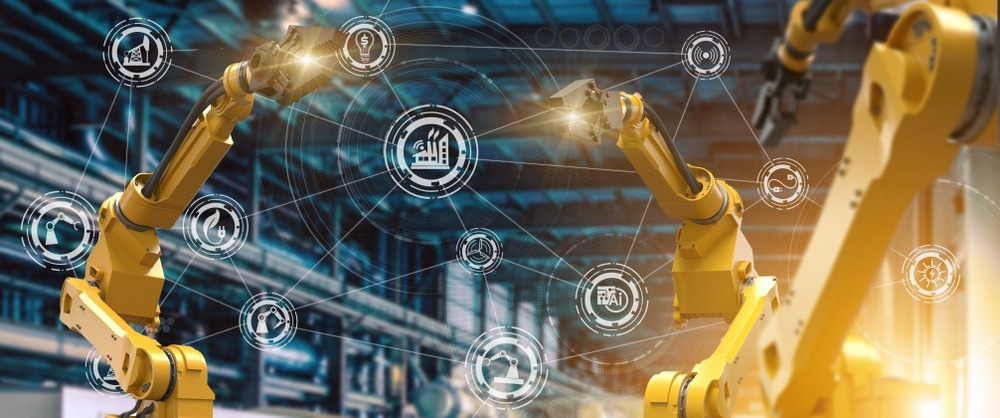An $8 million research project in the area of collaborative robots is being directed by the Department of Industrial Engineering. The European funds will support the development of devices that can alter behavior on their own without the need for human engagement.

Image Credit: Pand P Studio/ Shutterstock.com
Robotics are rapidly being used by industries to handle industrial control systems and manufacturing processes. Robots replace human labor, boost performance speed, and are effective in precise mechanical tasks. However, increasingly complex equipment must be constantly updated with new operating responsibilities, and when it becomes obsolete and must be disposed of, it has a significant environmental effect.
A working group at the University of Trento will spend the next four years building a robotic device capable of adjusting its behavior and adapting to new settings without the participation of humans, thanks to European funding.
The University of Trento’s plan, developed by Matteo Saveriano, a researcher in the Department of Industrial Engineering and European coordinator of the Inverse project, seeks to push the boundaries: it aims to create robots with the cognitive abilities needed to understand their surroundings, including human intentions and needs, decide what actions to take, adapt them, and make the necessary adjustments. Robots that are both interactive and intuitive.
We started from a very specific machine learning problem, that is the generation of safe and sensible behavior when devices are outside the world of training data, that is data acquired through artificial intelligence algorithms.
Matteo Saveriano, Assistant Professor, University of Trento
The research specifically addresses the issue of a robot changing a previously obtained task in total autonomy, without the assistance of an operator.
The project will have application settings in two industries: automotive and heavy industries. In the first scenario, the system will be tested to construct, remove, and recycle batteries for electric vehicles. A battery will be installed by the robotic device. The project’s ultimate objective is for the robot to utilize this information to investigate the demands of the environment in which it functions and disassemble the batteries.
In the heavy mechanical sector, the technology will instead be employed to promote an intelligent interaction between an operator, the robotic equipment, and an automated overhead crane. In this scenario, the purpose is to automate the cranes that are used to lift and move massive and heavy metal cargo from one location to another at a firm facility.
Currently, this operation is performed by an operator who also runs the overhead crane and frequently works in an uncomfortable and unsafe posture where accidents are prone to occur. As a result, the robotic equipment will take the place of humans in hazardous or disagreeable activities. Over the whole manufacturing process, operators will still be in charge of overseeing the job.
“Our idea is to let operators perform less repetitive and heavy tasks so that they can use all the intellectual abilities of human intelligence such as imagination and the ability to solve problems, that machines cannot do. We would like to let robots handle the materials and put people in a safer position. In this way, humans would supervise the work of machines and make sure it is as precise as possible,” Saveriano added.
The initiative complies with EU policies for the green and circular economy. The recycling of battery components is one of the biggest issues facing the automobile sector. Batteries are now produced using various assembling methods and by various businesses.
Since no two batteries are alike, the sorting, disposal, and reuse of these materials is an extremely difficult operation. By using incredibly creative solutions and adaptable learning strategies that quickly adjust to the battery's components, Inverse hopes to automate this process.
To further aid in the removal of industrial waste, the robotic devices will be able to measure a product’s energy efficiency, the number of greenhouse gases it emits, the resources it uses, and the rate at which it is recycled.
However, the project includes additional sustainability objectives. To prove without a shadow of a doubt that this is more practical than training a new device, the researchers would want to employ the same devices that have been trained to disassemble with just minor modifications.
The Inverse Project
The University of Trento’s Idra interdepartmental robotics laboratories, which are also affiliated with the Department of Information Engineering and Computer Science, collaborated to create Inverse.
Six of the project’s ten partners are academic institutions or research centers: the Universities of Mondragon (Spain) and Bogazici (Turkey), the Technical Research Center of Finland, the Create consortium of Federico II University of Naples, the University of Vienna, and the German Space Agency (Dlr). The remaining four partners, MTU Civitta Foundation, KroneCrane AG, Centro Ricerche Fiat, and Steinbeis Europa Zentrum, are all involved in the industrial sector.
The European Union has funded this Research and Innovation Action (RIA) initiative with eight million euros. In January, the project will get underway. By 2027, scientists want to have the first working robot prototype that can be tested in a lab setting that mimics an industrial setting.